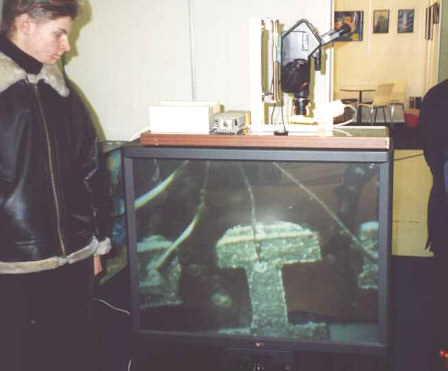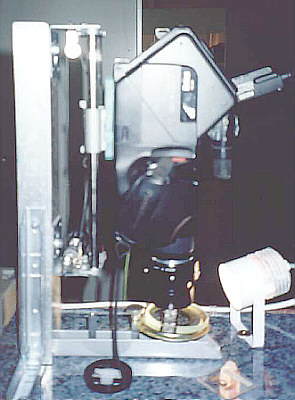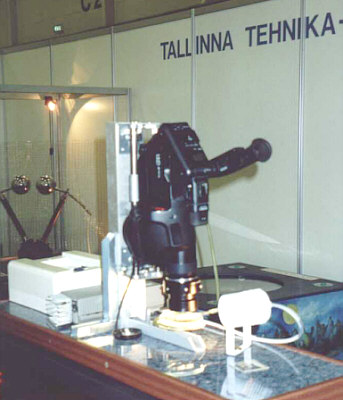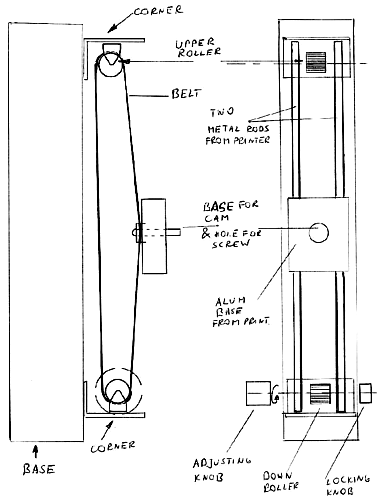A video macroscope / microscope project - and its use for an interactive exhibit by Aare Bäumer, Tallinn, Estonia |
I've been interested in amateur science for many years and started to cooperate with the newly-born Tallinn Technology and Science Centre ENERGY this last year. I found that they had a lack of educational exhibits and other interactive equipment, so my idea was to recreate some energy related exhibits of inventions from the 19th and beginning of the 20th century.
To date, I have designed two Tesla coils, one of them is 80x10 inches (2kW) and a large van de Graaf generator (110 inches high). I also have a Kirlian photography exhibit (from Mr. Craig, MI, USA, Tesla Web Ring). These are items that attract great interest amongst the science centre's visitors. Due to the small number of visitors, we have only two science centres in Estonia and I'm working for both of them.
A month ago I visited the Society of Amateur Scientists web site and Microscopy-UK web site and was interested in the video macroscope / microscope designs described and thought they looked a useful project for myself. So I started to experiment with different lenses and eyepieces. I have lot of spare optics as I am a former lighting designer with a working experience of over 20 years.
The video microscope is shown on its home-made focusing stand sitting on top of a Sony 100Hz large screen TV.
The electronic chip under the video microscope and displayed on the TV was specially ordered from an electronics surplus store and has a total area of 1/6 square inch (4.2 x 4.2mm). The video microscope clearly shows how the connectors are soldered onto the chip.
The pictures displayed above and below were taken during a large, electricity related exhibition, where science centre workers and I created the small interactive area for video microscopy. Some of the pictures, taken from a very short distance, are not of a good quality, so I've included a hand drawn plan (below) to illustrate the construction of my video microscope project.
Image above and right: Two closer views of the video microscope. The Panasonic NV095 S-VHS camcorder is mounted vertically on the modified print head carriage from a computer printer. The toothed belt from the printer carriage drive is also used for vertical lift and focusing.
The unit was completed within two weeks including the brainstorm about the camera lifting mechanism!
The external lamp is a halogen, 12V 30W unit with mains power supply. The whole unit is mounted on a home-made but professional looking base for public exhibition and use.
(One of the author's high voltage exhibits is shown in the background).
Below: sketches of the unit's construction showing the use of the
printer head carriage assembly and belt feed for focusing.
The following set-up I found promising:
1 . To make your own video macroscope/microscope using a consumer video camera, you can attach the lens from a 35mm single lens reflex (SLR) camera. At first I used the 50mm focal length f2,8 lens from a German made SLR camera. For mounting this lens, I used an adaptor for mounting filters on the lens mount when used with a reversing ring. <Editor's note: i.e. this would convert the bayonet mount on an SLR lens to a filter thread more suitable for atttaching to a video camera>. When looking for the right adaptor/mount for a camera, choose, of course a large well stocked photographic dealer. Take your camera with you and check ALL the rings and other adaptors available to see what suits. For my set-up I had a look through a large packet of rings (for a lot of different cameras) and settled on the metal ring for supporting telescopic lenses. After a short period of experimenting, I also found that a cylindrical plastic lampshade/diffuser of the right diameter for mounting the SLR lens to the video camera was even simpler. I drilled six small holes in the lampshade walls which supported the SLR lens inside and friction fitted the other end to the camcorder lens. You can use glue and a PVC tube to support the SLR lens, if drilling is not preferred.
2. A second approach is to use old 16mm movie projector lenses. The mounting only took one hour, because the projector's lens holder was used. You may also find that 8mm movie projector lenses are suitable.
3. To make a stable lifting and focusing mechanism for the video camera, I used a print head carriage from an old computer printer. You also need the toothed belt from the printer carriage drive! The belt with adjusting and fixing knobs is mounted directly to the home-made aluminium support. The whole assembly is very rigid if bolted together with the sturdy 90 degree angle brackets available from DIY stores.
Print head carriages from old printers may also be useful for making a mechanical stage for subjects inspected under the video microscope.
4. Finally, you can construct a nice looking base for the unit, made for example from wood, acrylic work surface material or something similar. An attractive base will help create a professional looking exhibit. This is important if you want the visitors not only to be attracted to and use your microscope, but also to respect it!
5. When using the above design as an interactive exhibit, visitors remarked that they wanted to see both the subject by eye and the TV screen image at the same time, so that they could relate the magnified image to the subject. To achieve this, the monitor must be very near the video microscope. They wanted to manoeuvre common objects (like hair, pennies etc) by their own hands under the video microscope to appreciate the sense of magnification they were observing. A video microscope with a very high enlargement is absolutely fascinating for many purposes especially to those familiar with microscopy. But if members of the public can't recognize any common elements of the subject from the screen image, they will leave the exhibit. I also found that opened microchips and other micro-miniature electronics had more appeal than biological subjects. Maybe it was just that the visitors were electronics enthusiasts, I don't know!
6. I calculated the magnification factor for the set-up using my domestic TV set (screen diagonal 18 inches):
For the video camera with 50mm SLR lens - screen enlargement is about 40X.
For the video camera with lenses from a 16mm movie projector - screen enlargement is about 140X.
My video microscope set-up has the following field of view: 1/12 inches (2.1mm) by 1/8 inches (3.2mm).
However, the above project was too easy a challenge and I'm now developing a more sophisticated version of my video microscope!
Comments to the author Aare Baumer are welcomed.
Aare Bäumer, Linnam, e tee 49-161 Tallinn, Estonia, Postal code 13911.
Tel +372 6607830. Fax +372 6607828. E-mail: aare.science@mail.eeAbout the author: I'm 40 years old and a former lighting designer, married, with two children. Most of my time is spent on different technical projects, including a variety of educational exhibits.
The author was encouraged to start experimenting with video microscopy after reading Shawn Carlson's article 'Home movies of an invisible world' in the 'Amateur Scientist' series of Scientific American.
Editor's notes: We were delighted to receive and share this contribution, and the idea of using a print head carriage assembly seems particularly neat. An inspection of the mechanics of my cheap inkjet printer shows a similar sturdy rail, platform and toothed belt drive. Commercially engineered focusing rails for macro/micro equipment can be expensive so this seems a good use for any redundant printers with suitable mechanics!
The security style video cameras (i.e. with 'C' mount removable lenses) described in the Micscape article by John Wojtowicz and Beyond article by Dave Walker perhaps could also be adapted to suit the type of stand and focusing described by Aare above.
Microscopy UK Front Page
Micscape Magazine
Article Library
© Microscopy UK or their contributors.
Published in the April 2000 edition of Micscape Magazine.
Please report any Web problems or offer general comments to the Micscape Editor,
via the contact on current Micscape Index.Micscape is the on-line monthly magazine of the Microscopy UK web
site at Microscopy-UK



